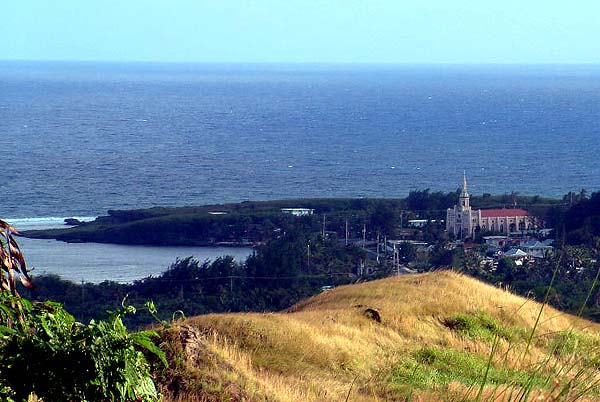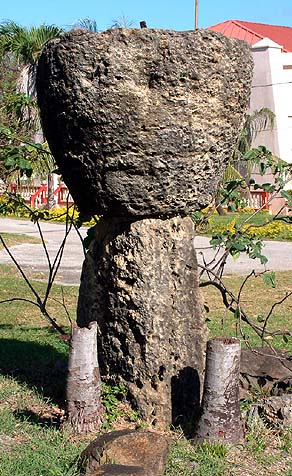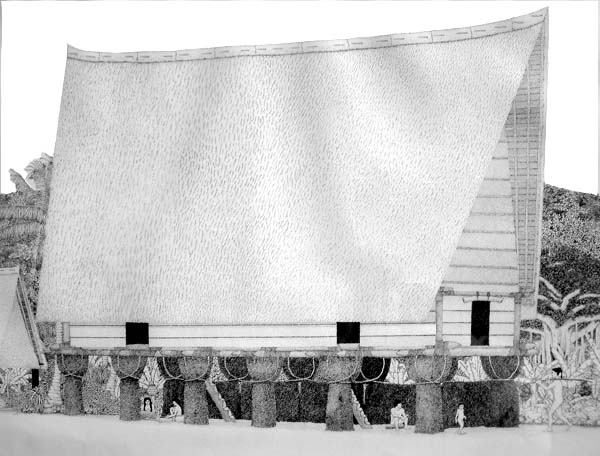 |
 |
 |
 |
||||
|
|
|
|
|
|
|
|
|
|
|
|||||||
|
|
|
|
Inarajan village as seen from the water tanks above the middle school.
|
|
|
“Chamorro villages were clan settlements.” Anne Hattori explains some aspects of traditional Chamorro settlements. “Within the clan area you have the cooking houses and the sleeping houses and the guma‘ uritao, or men’s house. In most villages you will find a latte house. My guess is that the largest latte houses were guma‘ uritao. Those would have been the biggest, since that’s where everyone congregates. And some of the sleeping houses for the highest ranking of elders might have been latte houses, if your family had the resources. "Not every house would have been a latte house, and definitely the canoe houses were low to the ground. The canoe houses were raised but they weren’t latte structures. They were just raised enough to have some ventilation. So it seemed like in every village, the clan would aspire to have at least one latte structure for the bachelor house. It also seems that over time, they were getting bigger."
|
||
|
|
||
|
"Apparently the oldest latte stones have been dated back to about 800 A.D. So the period we call the ‘Latte Period’ is about 800 to 1668, which is when San Vitores arrives. So there’s about an 800-year period when these were being built. "Now the word ‘latte’ itself means like ‘a stone carved,’ a stone carving that you pay respect to. The latte stones were primarily limestone in composition. There are some that have been found that look like they’ve been carved out of the mountains, but the majority of them are limestone. These were burned out, and the Chamorros had a technology for burning limestone, because that’s the same lime that people chew with betel nut. You burn down coral until it’s just ash. "Each latte is two pieces. There’s a bottom part, the base (haligi, "post") and then a top part (tåsa) that looks like a cup. These lattes would be arranged in two parallel columns, consisting of from six to twelve latte stones total. Two rows of six each is the biggest ones. These were the foundations for houses."
|
|
|
|
"It’s not really known why
they started building lattes, but definitely over time they
were getting bigger, and so some people have analyzed that as perhaps
a competition between villages, between clans. It’s like today:
the biggest house, the richest person, I guess. "My assumption is the latte was respected partly because it’s carved out of the land, hence the whole connection to nature and respect for nature is part of all of that belief. But the double connection to the burials increases the sacredness of it. So among Chamorros, when you’re around lattes, you have to be very careful."
|
|
|
|
|
|
|
“One of the practices that I think is very misunderstood is the practice of the guma' uritao. The guma' uritao is a bachelor house. 'Guma' means house and 'uritao' means bachelor. In every village you had a bachelor house, sort of a men’s house, which was also a place where teenage boys met to learn everything from fishing to how to build a house, to reading stars.
|
||
|
|
||
|
"It’s really like a school, a meeting place to learn even things like fighting skills, making sling stones, practicing throwing them, building canoes, building houses, everything. "But what’s unique about it is that women were allowed in. Since that’s where the unmarried men were, that’s where females were sent to meet up with future spouses. So in this practice you had the men who have a place where they’re meeting, and the females from different villages are coming over to meet up with bachelors."
A sling and a sling stone. |
|
|
|
|
|
|
"Men were stationary because the men, their responsibility was to stay on their family land and protect the land, so the women could have mobility because they weren’t the ones responsible for protecting the land. They owned the land through their mother but their brothers were the ones who were responsible for guarding it. So that’s why the men in the culture did not leave the land. "When you got married, women moved to where their husbands lived, their husbands' land. So the males in the family never moved. It’s the females that are moving, and if marriage breaks up, the woman goes back to her clan land."
|
|
“From the Spanish perspective, that reflected very poorly on the women. It looked to them like the women were very promiscuous: they’re hunting out men, and in some of the accounts, they say women are buying their husbands. One account equated it to prostitution, like ‘women of the night,’ ‘women of the street’ — you know, walking around from village to village. But culturally, that’s how the practice went. "So the Spanish interpretation of it was, 'bad mothers and bad daughters.' Mothers, how can you let your daughters out at night to go to these houses? And in a number of accounts, the priests would stand outside these guma’ uritao and preach to the girls who were coming out, about what bad women they were. Some accounts say the priests had to close their eyes or close their ears because they didn’t want to hear what was going on in those houses, and referred to them as ‘whore houses'. "
|
|
|
|
|
|
"A lot of the Spanish accounts fixated on the sex part, rather than looking at that whole institution of the guma' uritao. It was a big part of the culture. “Of course one of the Spanish reactions was to burn it down. One of their methods for ending that ‘sinfulness’ was to burn down the guma' uritao. So you burn that down, yes you may be ending something, you may be taking away that physical place to meet, but you’re also disrupting, I think, a lot of the men’s activities, where the men were learning all their skills for manhood."
|
||
|
|
||
|
Since the guma' uritao and the latte houses are long gone, Chamorro houses have gone through an evolution. Inarajan, with historic preservation status, still presents a lesson on the evolution of Chamorro houses.
|
||
|
|
||
|
|
|
|
|
|

|
| Inarajan Home | Map Library | Site Map | Pacific Worlds Home |
|
|
|
|
|
|
|
|||
| Copyright 2003 Pacific Worlds & Associates • Usage Policy • Webmaster |
|||









